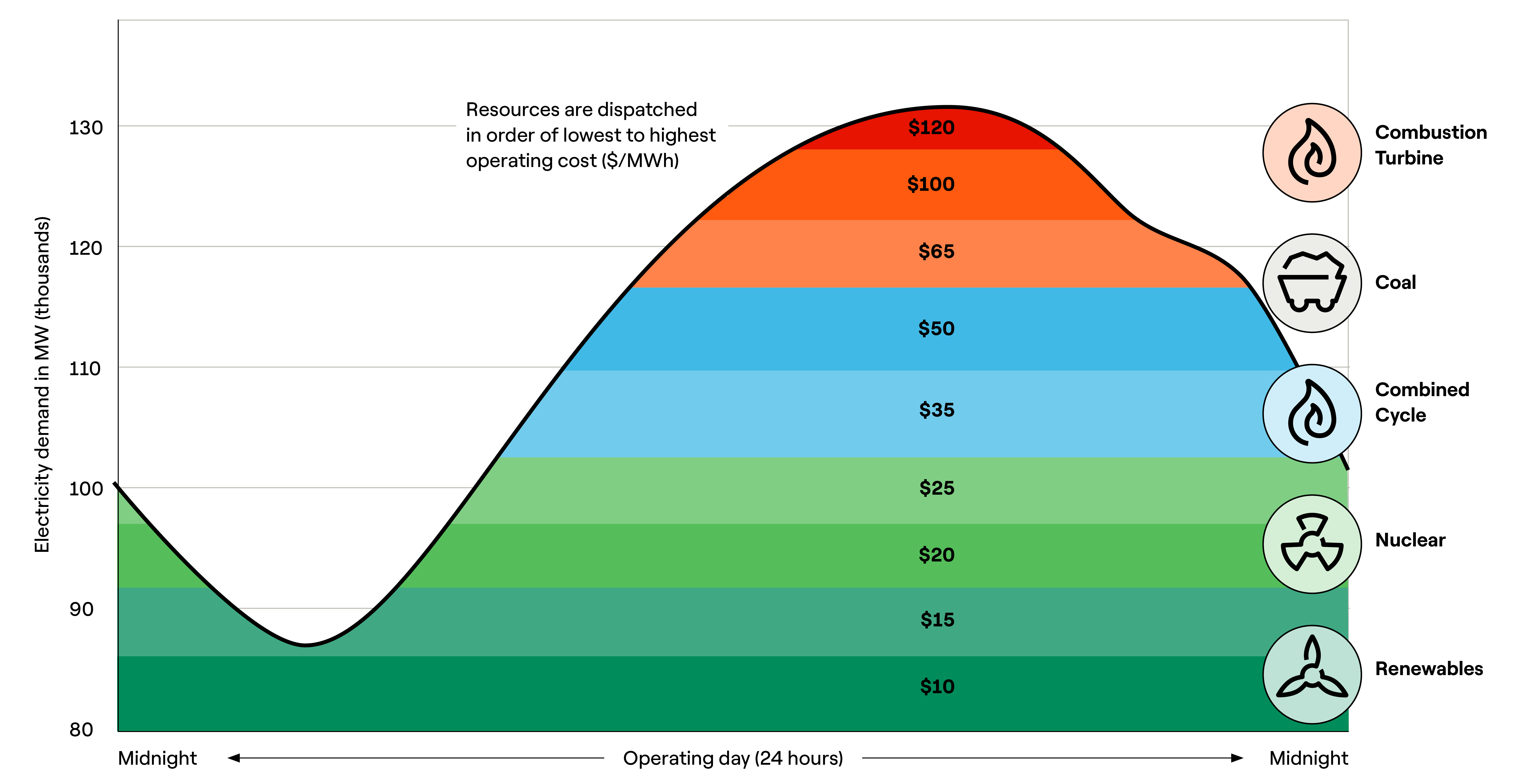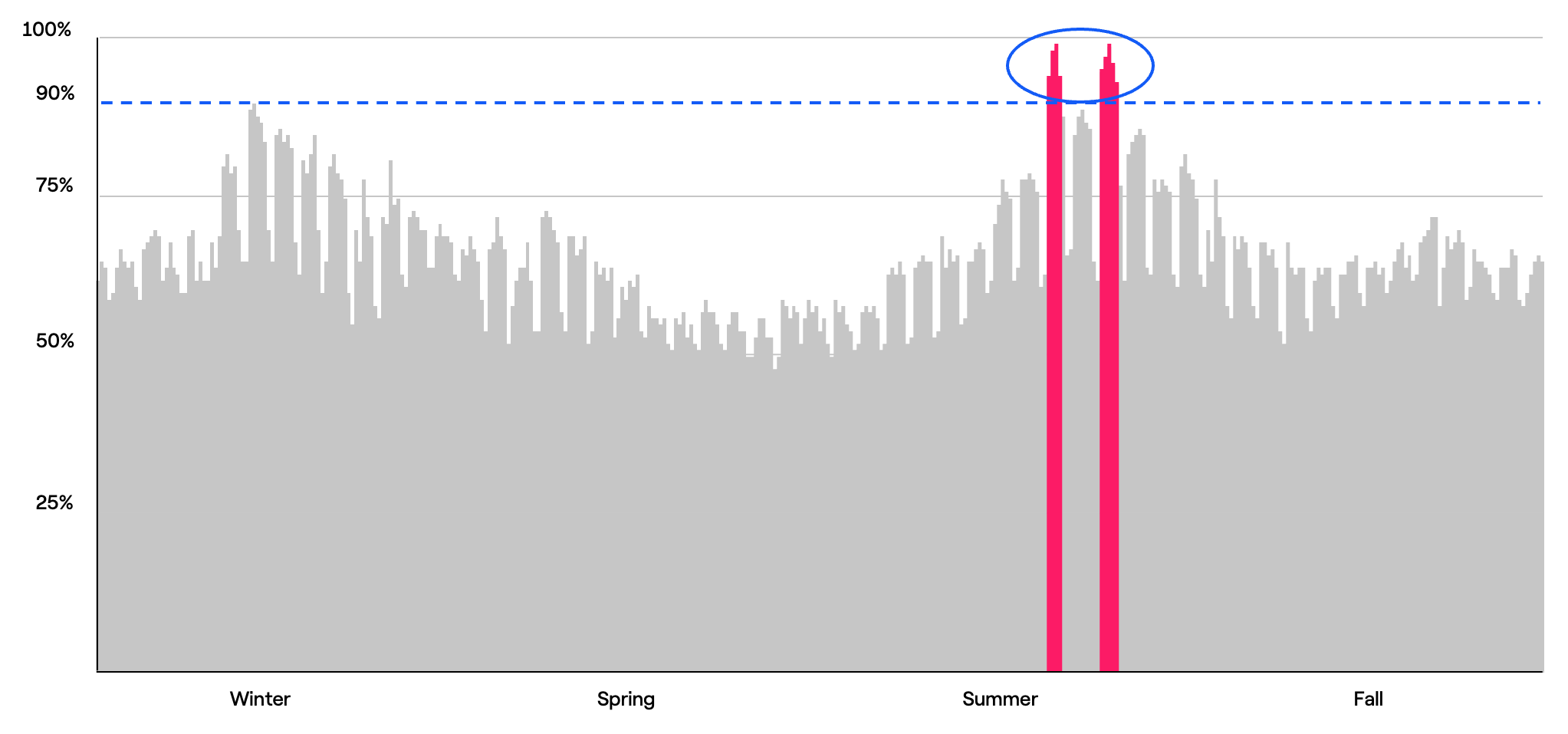Profiting from energy flexibility
Download our eBook to find out how to unlock the revenue potential in your energy infrastructure – and where you may already have that flexibility in your organization.
05 11, 2023
{{ content.description }}
To realize the benefits that demand response offers to the electric grid, it’s important to understand the concept of peaking power plants. The electric grid was originally built to accommodate and run on fossil fuels. However, both supply and demand have changed drastically over the years. Demand response is one part of that evolution of supply and demand – by paying energy users to reduce their demand for grid energy at times of grid stress, demand response helps to keep power flowing and reduces the need for the use of peaking power plants.
But what are peaking power plants?
A peaking power plant (or “peaker plant” for short) is a power plant that grid operators call on at times of particularly high electricity demand on the grid. Peaker plants supply power that is not only high in cost but also typically high in greenhouse gas emissions.
To understand peaker plants, it’s important to realize not all energy generation is created equal – power sources are typically called on by grid operators in order of marginal cost. As you can see in the chart below, the higher cost assets that are called when demand is very high are typically more fossil fuel-intensive – gas turbines, for instance, are common peaker plants because they can quickly start and ramp up at times of high demand. Since there is only so much generation at any time and supply can fluctuate, additional generation is needed to meet any potential shortfalls – and when demand is high enough, grid operators have traditionally relied on peaker plants.

Illustrative example from PJM
Traditionally, peaker plants have been used to ensure grid reliability during high demand periods. As such, peaker plants generate power for limited hours each year, spending most of their time on call in case they are needed. Grid operators spend a large amount of money on operating and maintaining these highly polluting plants so they can be ready to quickly start up at times of peak demand, which are rare but dangerous moments on the grid. An estimated 10% of grid infrastructure is built to supply energy during times of dangerous peak demand, which only make up 1% of the year.
The chart below shows demand as a percentage of available capacity in one region for an entire year, with most days staying well below 75% of capacity. But on high demand days like those in red – typically days that feature extreme weather like heat waves – peaker plants have traditionally been important for grid operators as they can quickly turn on and supply energy.

As the grid evolves to include more intermittent energy resources like solar and wind energy, there is an increasing need for capacity that’s able to respond on a short notice. Whereas peaker plants used to fill this role, it’s increasingly important to find alternative solutions that are more cost-effective and sustainable.
That’s where flexibility comes into play. Supply-side flexibility, like peaker plants, used to be the driver for maintaining balance in the grid. But now, grid operators are increasingly leveraging demand-side energy flexibility as a way to manage peak energy demand while reducing the need for high-emitting peaker plants. One such demand-side energy flexibility solution, demand response, can reduce the usage of peaker plants – grid operators call on demand response resources at times of grid stress or imbalance, instead of relying on peaker plants.
Demand-side energy flexibility – what we refer to simply as “energy flexibility” – is an energy user's ability to reduce their energy use or shift that usage to different times of day when requested by the grid operator. Energy flexibility can reduce demand on the grid, which has essentially the equivalent effect of increasing supply – it helps the two aspects to remain in balance. This can be particularly crucial at times of peak demand, when demand response and other energy flexibility solutions can help reduce the need for peaking power plants.
Grid operators encourage energy flexibility in a variety of ways – whether explicitly in a program like demand response or implicitly through price signals to encourage energy users to avoid using energy at times of peak demand.
There are a variety of energy flexibility solutions beyond demand response, including:
Often, multiple flexibility solutions can be combined into virtual power plants (VPPs), which connect distributed energy resources and operate them together. One study by the Brattle Group found that, in the future, VPPs could offer the same amount of capacity as peaker plants at much lower cost and emissions levels.
For now, peaker plants remain important to the operation of the grid. But many peaker plants are due for retirement in the years ahead, and there are debates about the role of these power plants as North America tries to decarbonize its grid. In addition, there are significant concerns about environmental justice with these high-emitting plants.
Thinking beyond peaker plants, energy flexibility solutions are increasing in importance – in 2022, Enel witnessed a record for demand response events, continuing a years-long trend. And opportunities for demand response and flexibility are expected to continue growing in the years ahead, as extreme weather increases and the grid continues to age.
As a result, there is more potential than ever for organizations in the coming years to receive financial compensation for providing energy flexibility services. Organizations that don’t participate are leaving money on the table. Contact Enel to talk to an expert about your revenue potential by leveraging energy flexibility, or download our “Profiting From Energy Flexibility” eBook to learn more about unlocking flexibility in your operations.